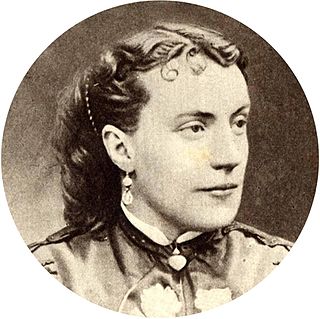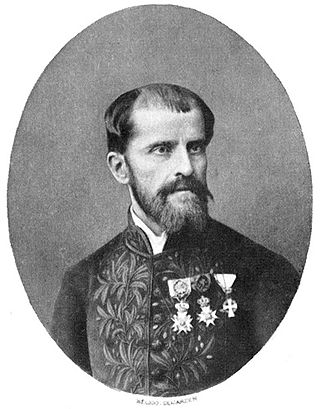
Caran d'Ache was the pseudonym of the 19th century French satirist and political cartoonist Emmanuel Poiré. The pseudonym comes from Russian: карандаш, romanized: karandash meaning "pencil" in Turkic languages. While his first work glorified the Napoleonic era, he went on to create "stories without words" and as a contributor to newspapers such as the Le Figaro, he is sometimes hailed as one of the precursors of comic strips. The Swiss art products company Caran d'Ache is named after him.

Marie Joseph Gabriel Antoine Jogand-Pagès, better known by the pen name Léo Taxil, was a French writer and journalist who became known for his strong anti-Catholic and anti-clerical views. He is also known for the Taxil hoax, a spurious exposé of Freemasonry and the Roman Catholic Church's opposition to it.

Stephen Jean-Marie Pichon was a French journalist, diplomat and politician of the Third Republic. The Avenue Stéphen-Pichon in Paris is named after him.
René Rémond was a French historian, political scientist and political economist.
Henri-Irénée Marrou was a French historian. A Christian humanist in outlook, his work was primarily in the spheres of Late Antiquity and the history of education. He is best known for his work History of Education in Antiquity. He also edited, for Sources Chrétiennes, the early Christian work Letter to Diognetus, the only manuscript of which perished in a fire at the University of Strasbourg during the Franco-Prussian War. Marrou edited the collection Patristica Sorbonensia, published by Le Seuil. His work has been criticised by the philosopher Ilsetraut Hadot. Marrou also wrote under the pseudonym of Henri Davenson. His Carnets posthumes were published in 2006 under the editorial supervision of his daughter Françoise Marrou-Flamant.
François Nau was a French Catholic priest, mathematician, Syriacist, and specialist in oriental languages. He published a great number of eastern Christian texts and translations for the first and often only time.

Robert Arnauld d’Andilly was a French conseiller d’État, specialising in financial questions, in the court of Marie de' Medici. By the elegance of his language, he was among the major poets, writers and translators of 17th century French classicism. A fervent Catholic, he played an important role in the history of Jansenism and was one of the Solitaires of Port-Royal-des-Champs. He was also renowned for his part in the development of the pruning of fruit trees, to which he was devoted.

Jacques Élie Henri Ambroise Ner, also known by the pseudonym Han Ryner, was a French individualist anarchist philosopher and activist and a novelist. He wrote for publications such as L'Art social, L'Humanité nouvelle, L'Ennemi du Peuple, L'Idée Libre de Lorulot; and L'En dehors and L'Unique of fellow anarchist individualist Émile Armand. His thought is mainly influenced by stoicism and epicureanism.

Père Lachaise Cemetery is the largest cemetery in Paris, France. With more than 3.5 million visitors annually, it is the most visited necropolis in the world. Notable figures in the arts buried at Père Lachaise include Michel Ney, Frédéric Chopin, Émile Waldteufel, Édith Piaf, Marcel Proust, Georges Méliès, Marcel Marceau, Sarah Bernhardt, Oscar Wilde, Thierry Fortineau, J.R.D. Tata, Gertrude Stein, Jim Morrison and Sir Richard Wallace.

Thérésa was a French singer. She often worked with Suzanne Lagier and had cartoons (caricatures) drawn by André Gill of her for the newspaper La Lune.
Édouard Didron (1836-1902) was a French stained glass artist and art writer.

La Caricature was a satirical weekly published French periodical that was distributed in Paris between 1830 and 1843 during the July Monarchy. Its cartoons repeatedly attacked King Louis Philippe, whom it typically depicted as a pear.

Jean Victor Charles Edmond Leune was a French war correspondent, writer, press photographer, military aviator and member of the French Resistance.

L'Assiette au Beurre was an illustrated French weekly satirical magazine with anarchist political leanings that was chiefly produced between 1901 and 1912. It was revived as a monthly for a time and ceased production in 1936.

Charles Palissot de Montenoy was an 18th-century French playwright, admirer and disciple of Voltaire and Antoine de Rivarol. Paradoxically, he was often denounced as a Counter-Enlightenment opponent to the parti philosophique, especially for his criticism of Diderot and the Encyclopédistes. He is the author of the comedy, Les Philosophes, which was a huge success and caused a scandal in 1760.
Ernest Fouinet was a 19th-century French novelist and poet.

Didier Dubucq was a mysterious Belgian cartoonist and journalist. Freethinker and anti-clerical, he founded the newspaper Les Corbeaux, which he directed between 1904 and 1909. He sometimes signed his caricatures as "Ashavérus".

The clandestine press of the French Resistance was collectively responsible for printing flyers, broadsheets, newspapers, and even books in secret in France during the German occupation of France in the Second World War. The secret press was used to disseminate the ideas of the French Resistance in cooperation with the Free French, and played an important role in the liberation of France and in the history of French journalism, particularly during the 1944 Freedom of the Press Ordinances.

Didier Ben Loulou, is a Franco-Israeli photographer.

Paul Edouard Didier Riant was a French historian and scientific editor specializing in the Crusades.















